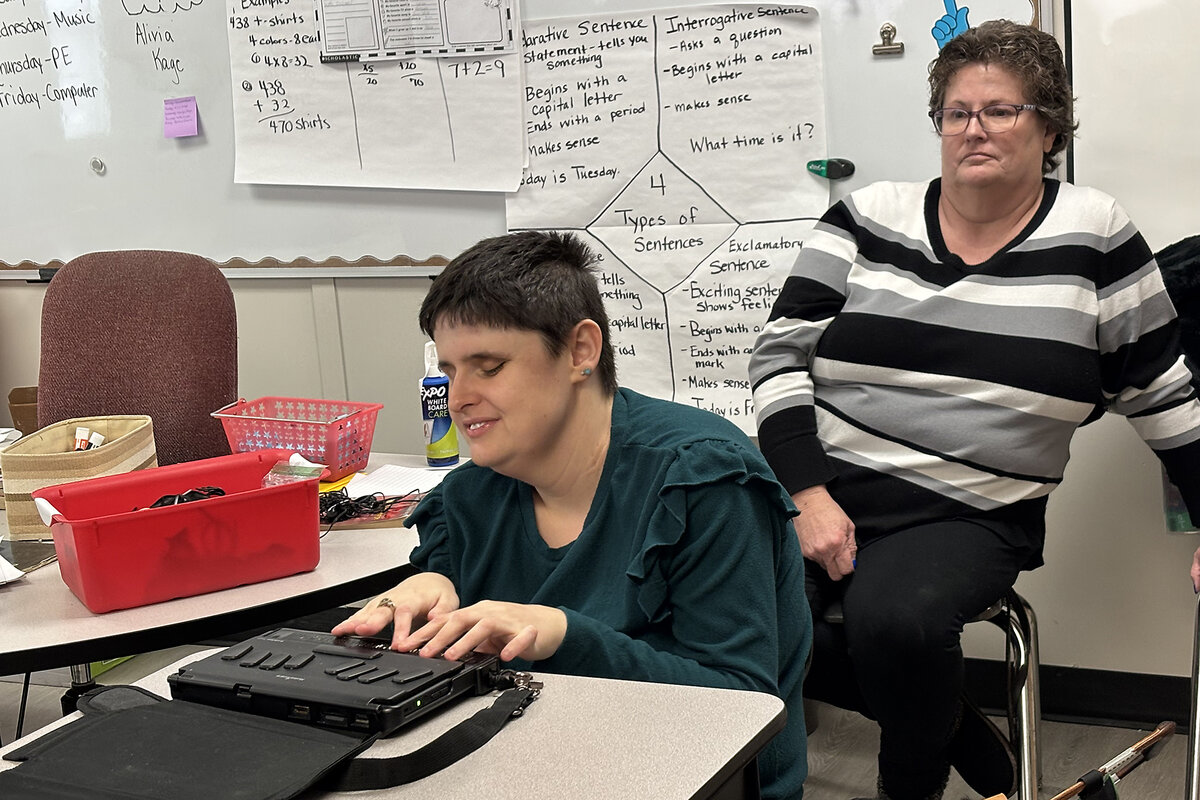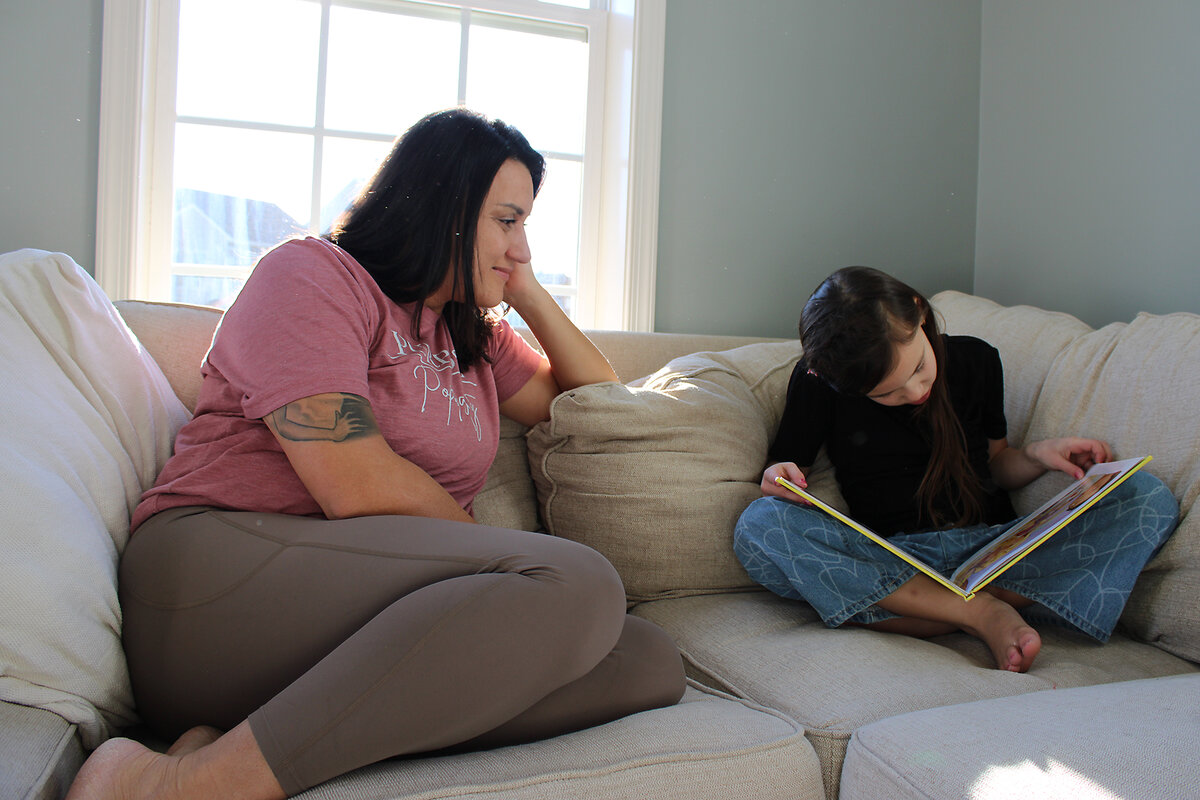US children are struggling with reading. Can communities help?
Loading...
| Berkeley County, W.Va.
Casey Willson receives a celebrity welcome as he enters a classroom at Gerrardstown Elementary in March. His fans – kindergarteners smiling and waving – are waiting for the show to begin.
“Are you ready?” he asks.
“Yes!” the children shout excitedly.
Why We Wrote This
A story focused onAt a time when U.S. students are falling further behind in reading, volunteers in West Virginia are on a mission to reengage them. They are among those modeling the idea that building strong readers requires community, and a cultural shift.
It’s time for the big reveal. Mr. Willson – or Mr. Casey, as the kids call him – sits on a turquoise chair and holds up a picture book called “Nigel and the Moon.”
“Here we go,” says the volunteer with Read Aloud West Virginia. “Now, this is about what you want to do when you grow up.”
With that, he opens the book and begins reading – adding sound effects, hand gestures, and occasional observations about the story. His audience, prone to fidgets during ordinary school hours, hangs on every word.
Getting children to engage with reading is a high priority in West Virginia and across the United States, where troubling results from the assessment dubbed the “nation’s report card” this year showed students continuing to fall further behind. In a country filled with struggling readers, the volunteer-led program Mr. Willson works with is one example of an approach that starts inside a classroom but is, very intentionally, meant to expand beyond those four walls. In other words, it takes a community – and a cultural shift – to develop strong readers.
“When [Mr. Willson] shares his love of reading, it encourages them to go home and read with their parents or read to a young brother or little baby sister,” says kindergarten teacher Patricia Edwards.
Learning beyond the schoolhouse door
The latest national test results, released in January, underscore the grim reality that many U.S. students simply aren’t good readers.
Average reading scores for fourth graders and eighth graders slipped again – by 2 points since 2022 – on the National Assessment of Educational Progress, or NAEP. The decline continued a trend that began before the pandemic. Four out of every 10 fourth graders and a third of eighth graders are reading below the test’s basic level.
West Virginia students’ reading scores did not significantly change since 2022, though the state still trails the national average.
Many school districts in the U.S., including those in West Virginia, have been shifting toward the science of reading, an evidence-backed instructional method, to improve literacy skills. The Mountain State has also placed assistant teachers in early childhood classrooms, giving educators more time to work with small groups of students.
Ryan Saxe, superintendent of Berkeley County Schools in West Virginia’s eastern panhandle, says the goal is to develop “prolific readers,” not just proficient readers. The district leader says his students aren’t there yet, but they are making strides – in part through help from the community.
“Learning does not begin and end at the schoolhouse door,” he says.
Creating a reading culture
Read Aloud West Virginia, which dates back to 1986, operates chapters in about 30 of West Virginia’s 55 counties. One of its founders, Mary Kay Bond, started reading newspapers, magazines, and books to her baby son after being gifted “The Read-Aloud Handbook” by Jim Trelease.
Ms. Bond noticed her child’s vocabulary blossom. Research touts other benefits of reading to children, such as expanding their background knowledge and developing empathy.
“It’s more than just reading,” says Rebecca Deutscher, a senior research associate at the Language to Literacy Research Lab at Stanford University’s Graduate School of Education. “It allows engaging in conversations and questions.”
Today, roughly 1,000 volunteers – retirees, lawyers, parents, Air National Guard members, and a woman who reads books in braille – visit classrooms across the state each week. They’re not there to teach students how to read. Instead, it’s about nurturing excitement.
Dawn Miller, the organization’s executive director, likens the strategy to athletic traditions. In West Virginia, she says, many children grow up cheering for Marshall University’s or West Virginia University’s sports teams for a simple reason: Parents, grandparents, or other adults have modeled loyalty to the home squads.
“Those activities become important in our culture,” she says. “So Read Aloud says, ‘Now, let’s do the same thing around books and reading.’”
The group’s effort includes two key ingredients that correlate with student success: It places volunteers in schools and more books in the hands of children.
The organization is on track to distribute more than 1,200 “book bundles” – five books on a topic that interests a student – by the end of this school year, says Ms. Miller. It’s a newer aspect of Read Aloud’s mission, made possible through grants and other donations.
“The kids were over the moon,” she says of the book bundle deliveries. “It was like Christmas morning.”
Much of the organization’s feedback is anecdotal. An educator in Ripley, a rural and lower socioeconomic area near the Ohio River, recently sent Read Aloud a letter sharing information about students’ academic growth after a book bundle delivery. Tonia Carpenter, principal of Fairplain Elementary School, noted the percentage of third graders reading at or above grade level, per a benchmarking test, rose from 59% at the beginning of the year to 87% midyear.
“Exposure is the key for these students and this type of reading was a perfect match,” Ms. Carpenter wrote.
The latest NAEP data suggests it could help move the needle on academic achievement. Reading test scores for fourth graders climbed in relation to the number of books students reported having at home.
The number of volunteers present in a school appears to have a similar effect on students’ reading scores. (The survey question, however, did not delineate the type of volunteer work being performed.)
Volunteers say the benefits run both ways.
On a recent morning, Bob Fleenor finishes reading “Because of Winn-Dixie” in a fifth grade class. The students applaud. And one, Tyler Marshall, announces, “We’re a bunch of book nerds!”
It’s the type of response that motivates readers like Mr. Fleenor to keep coming back.
The retired newspaper reporter still remembers the thrill of one of his teachers reading “The Secret Garden,” a book he may not have taken an interest in otherwise. He hopes to evoke that same surprise and delight among the students who now listen to him read stories plucked from his personal collection of children’s chapter books, most of which he didn’t grow up reading.
“The interesting and diverse voices and subject matter which we’ve seen in the last half-century is amazing,” he says. “We had to bring ourselves up to speed.”
Books at bedtime
Seven-year-old Rhett glides her pink-painted fingernail under each word as she reads aloud to her mother, Deanna Linden. She sounds out words such as “asparagus,” “pistachio,” and “tangerine,” needing barely any help.
The book was a birthday gift. She’s proud to show visitors a heavily stocked bookcase in her bedroom.
“Sometimes I might fall asleep with the book on me,” Rhett says, describing her bedtime reading habits.
Her daughter’s enthusiasm puts Ms. Linden, who grew up in a home where education wasn’t emphasized, at ease. She never wanted her reading struggles to affect her children. But Rhett started coming home from school, especially after “Mr. Casey” visited her classroom, wanting to devour books.
“It makes me happy,” says Ms. Linden, who also doesn’t force it. She wants her daughter to retain the joy of reading without feeling obligated to do so.
Mr. Willson feels the same way when he hears about the carry-over effect at home. Pulling on research and his many years working in the business world, he has crafted an elevator pitch about the importance of reading. What’s good for children, he says, is also good for West Virginia and the nation at large.
“In today’s world, there are a lot of changes that need to be made,” he says. “And the most fundamental tool in anybody’s toolbox is literacy.”








